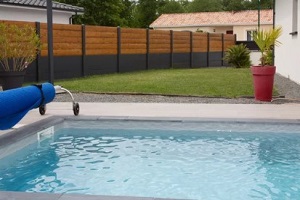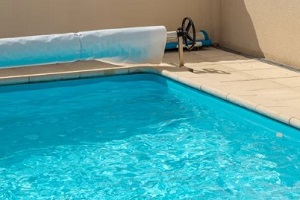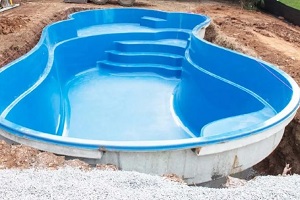 Adding a pool to your property can increase its value while also providing new and exciting leisure opportunities. Pools are available in a variety of materials, shapes and sizes, which means that homeowners will need to determine the option that is most suitable for their budget and specific space.
Adding a pool to your property can increase its value while also providing new and exciting leisure opportunities. Pools are available in a variety of materials, shapes and sizes, which means that homeowners will need to determine the option that is most suitable for their budget and specific space.
The two of the most common types of installed choices are vinyl and concrete pools, and each come with their own advantages and drawbacks. When considering vinyl as an option, many people envision an above ground pool kit.
However, top-quality vinyl is used for the creation of beautiful inground pools for many homeowners. The type of vinyl used for an inground pool is a superior product to that found in the above ground kits, and provides many benefits.
Here are the most important factors homeowners need to know about choosing the right pool option for their backyard.
Understanding Vinyl Pools and Above Ground Pools
Vinyl and concrete are the most common material choices when it comes to pools. In-ground vinyl pools provide a wide range of options in terms of shapes, colors and decor thanks to their composite polymer material. They are durable, easy to maintain and often fit seamlessly into a landscape.
Above ground vinyl pools are supported by an exposed frame and panels that are designed to manage the pressure of the water. Unlike inground pools with frames that are supported by the ground in which they are placed, if one of the panels or sections become damaged, it will compromise the integrity of the entire structure.
Above ground vinyl pools are out-of-the-box affordable and have a quick installation time for those experienced in setting them up. However, above-ground vinyl pools typically experience a far shorter life span and are more prone to exterior damage, as well as damage to the liner itself.
No matter which option homeowners choose, they will get more life out of their pool by choosing a high quality vinyl, and with regular maintenance and installation from professionals who are experienced with vinyl pools.
The Advantages of an Inground Vinyl Pool Installation
 Vinyl is a resilient material, which is why it is used so frequently in pools. It is adaptable and can be customized to create interesting visual patterns for those looking to upgrade their pool experience. Without the need for vinyl to cure as with concrete, pools made of this material are typically ready to use sooner.
Vinyl is a resilient material, which is why it is used so frequently in pools. It is adaptable and can be customized to create interesting visual patterns for those looking to upgrade their pool experience. Without the need for vinyl to cure as with concrete, pools made of this material are typically ready to use sooner.
Vinyl is available in a variety of colors and can be stamped to demonstrate complex and beautiful patterns. Vinyl is also soft and gentle on skin, so those going in and out of the pool are less likely to scrape their elbows and knees on rough material.
Unlike concrete, vinyl is far less porous, often requiring fewer chemicals to maintain balance and therefore, also holds up well against stains. Brushing the vinyl gently once per week is an effective way to prevent stains from developing at the water line. If stains appear, they can be treated with vinyl-specific products; the vinyl itself is typically receptive to cleaning that can remove stains.
In-ground pools tend to increase the value of a property because they are visually appealing and often crafted with the surrounding landscape in mind. In contrast, above ground pools do not contribute to the property value.
If an above ground pool is not surrounded by extensive decking, it may be considered to be personal property during a real estate transaction and in most cases may be required to be taken down as part of a sale.
Disadvantages to Understand
Vinyl liners feel softer to the touch and are gentler on skin than the rough surface of concrete, but in order to maintain this high-quality feel, the vinyl pool liner may need to be replaced every 10 years. Vinyl that is carefully cared for can last as long as 25 years before needing a replacement.
Without proper care, a vinyl pool liner can wrinkle or even tear. This can lead to less than pleasing visual impacts or leaks that result in the need to consistently refill the pool. However, proper care for vinyl pools can prevent these issues, and some fixes are even achievable by homeowners on their own.
For instance, if a vinyl liner begins to wrinkle, simply pushing the wrinkles to the edge can release the air trapped underneath and remove them. Issues with the consistency of the vinyl liner are more common in above ground pools, but they can happen in either type.
 One of the installation challenges faced by vinyl in-ground pools is that some types of landscape can make installation more difficult. If the yard is sloped or full of rocky terrain, the excavation effort required to create an opening for the pool may require extra effort.
One of the installation challenges faced by vinyl in-ground pools is that some types of landscape can make installation more difficult. If the yard is sloped or full of rocky terrain, the excavation effort required to create an opening for the pool may require extra effort.
However, careful site planning will enable installers to properly remove hazards, and using appropriate fill dirt, prepare the area for an in-ground pool almost anywhere.
Get Your Pool Installed the Right Way the First Time
If a vinyl in-ground pool is the right option for your home, the best investment is getting that pool installed correctly the first time. The pool installation process is complex, and doing it well requires years of experience.
The team at Masten Pools has been family owned and operated across more than 30 years of installations in Maryland and Delaware. Contact us to discuss your vision for a pool on your property or to ask questions about the right type for your backyard.
